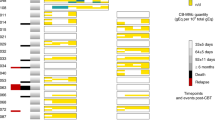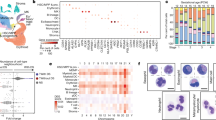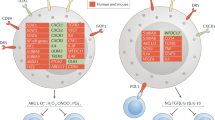Abstract
Fetal cell microchimerism is defined as the persistence of fetal cells in the mother after birth without any apparent rejection. Fetal microchimeric cells (FMCs) engraft into the maternal bone marrow for decades after delivery and are able to migrate to blood and tissues. This phenomenon was hypothesized to have a detrimental role in autoimmune diseases, but data are still controversial and debated. In malignant tumors, fetal cell microchimerism has been postulated to have a positive effect on tumor burden, although some evidence suggests that FMCs may be involved in neoplastic progression. At the peripheral level, circulating FMCs are less frequently detected in patients with thyroid cancer, breast cancer or other solid, hematologic malignancies than in healthy individuals, which suggests a protective role for fetal cell microchimerism. In tissues, FMCs have been found in tumor sections from malignancies such as thyroid, breast, cervix, lung cancers and melanomas and have been shown to differentiate into epithelial, hematopoietic, endothelial and mesenchymal cells. FMCs with hematopoietic differentiation have been postulated to have a role in destroying the tumor, whereas mesenchymal and epithelial cells could participate in repair processes. Endothelial cells, on the other hand, are believed to play a part in tumor progression. This Review provides an overview of the role of fetal cell microchimerism in autoimmune and benign or malignant nonautoimmune diseases. Moreover, the mechanisms by which fetal cell microchimerism is believed to modulate the protection against cancer or tumor progression will be discussed, together with future research directions.
Key Points
-
Fetal microchimeric cells (FMCs) can engraft into maternal bone marrow and provide a renewing source of fetal cells in maternal blood for decades after delivery
-
Three hypotheses have been put forward concerning microchimerism and human health: a chronic inflammatory response that causes tissue damage; a protective role in repair of tissues; or a physiologic event without biological significance
-
In systemic and nonsystemic autoimmune diseases, a pathogenic role of fetal cell microchimerism remains controversial, as study results comparing the number of FMCs in patients and healthy controls are conflicting
-
FMCs are more frequent in the blood of healthy women compared with patients with neoplasms, which indicates that FMCs have the potential to participate in immune surveillance
-
At the tissue level, FMCs are preferentially located in tumoral tissues rather than nontumoral areas and are morphologically undistinguishable from the surrounding maternal cells
-
Some FMCs are CD45-positive, possibly for tumor destruction, whereas others can differentiate into epithelial or mesenchymal cells to regenerate tissue or endothelial cells to participate in vessel formation
This is a preview of subscription content, access via your institution
Access options
Subscribe to this journal
Receive 12 print issues and online access
$209.00 per year
only $17.42 per issue
Buy this article
- Purchase on Springer Link
- Instant access to full article PDF
Prices may be subject to local taxes which are calculated during checkout




Similar content being viewed by others
References
Adams Waldorf, K. M. et al. Dynamic changes in fetal microchimerism in maternal peripheral blood mononuclear cells, CD4+ and CD8+ cells in normal pregnancy. Placenta 31, 589–594 (2010).
Fujiki, Y., Johnson, K. L., Tighiouart, H., Peter, I. & Bianchi, D. W. Fetomaternal trafficking in the mouse increases as delivery approaches and is highest in the maternal lung. Biol. Reprod. 79, 841–848 (2008).
Fujiki, Y., Johnson, K. L., Peter, I., Tighiouart, H. & Bianchi, D. W. Fetal cells in the pregnant mouse are diverse and express a variety of progenitor and differentiated cell markers. Biol. Reprod. 81, 26–32 (2009).
Nguyen Huu, S., Dubernard, G., Aractingi, S. & Khosrotehrani, K. Feto-maternal cell trafficking: a transfer of pregnancy associated progenitor cells. Stem Cell Rev. 2, 111–116 (2006).
Bianchi, D. W., Zickwolf, G. K., Sylvester, S. & DeMaria, M. A. Male fetal progenitor cells persist in maternal blood for as long as 27 years postpartum. Proc. Natl Acad. Sci. USA 93, 705–708 (1996).
O'Donoghue, K. et al. Microchimerism in female bone marrow and bone decades after fetal mesenchymal stem-cell trafficking in pregnancy. Lancet 364, 179–182 (2004).
Khosrotehrani, K. et al. Pregnancy allows the transfer and differentiation of fetal lymphoid progenitors into functional T and B cells in mothers. J. Immunol. 180, 889–897 (2008).
Leduc, M. et al. Limited functional capacity of microchimeric fetal hematopoietic progenitors acquired by mothers during pregnancy. Exp. Hematol. 38, 852–853 (2010).
Evans, P. C. et al. Long-term fetal microchimerism in peripheral blood mononuclear cell subsets in healthy women and women with scleroderma. Blood 93, 2033–2037 (1999).
Khosrotehrani, K., Johnson, K. L., Cha, D. H., Salomon, R. N. & Bianchi, D. W. Transfer of fetal cells with multilineage potential to maternal tissue. JAMA 292, 75–80 (2004).
Srivatsa, B., Srivatsa, S., Johnson, K. L. & Bianchi, D. W. Maternal cell microchimerism in newborn tissues. J. Pediatr. 142, 31–35 (2003).
Johnson, K. L., Zhen, D. K. & Bianchi, D. W. The use of fluorescence in situ hybridization (FISH) on paraffin-embedded tissue sections for the study of microchimerism. Biotechniques 29, 1220–1224 (2000).
Lambert, N. C. et al. Quantification of maternal microchimerism by HLA-specific real-time polymerase chain reaction: studies of healthy women and women with scleroderma. Arthritis Rheum. 50, 906–914 (2004).
Artlett, C. M., Smith, J. B. & Jimenez, S. A. Identification of fetal DNA and cells in skin lesions from women with systemic sclerosis. N. Engl. J. Med. 338, 1186–1191 (1998).
Lambert, N. C. et al. Male microchimerism in healthy women and women with scleroderma: cells or circulating DNA? A quantitative answer. Blood 100, 2845–2851 (2002).
Nelson, J. L. et al. Microchimerism and HLA-compatible relationships of pregnancy in scleroderma. Lancet 351, 559–562 (1998).
Selva-O'Callaghan, A. et al. Lack of evidence of foetal microchimerism in female Spanish patients with systemic sclerosis. Lupus 12, 15–20 (2003).
Murata, H., Nakauchi, H. & Sumida, T. Microchimerism in Japanese women patients with systemic sclerosis. Lancet 354, 220 (1999).
Gannagé, M., Amoura, Z., Lantz, O., Piette, J. C. & Caillat-Zucman, S. Feto-maternal microchimerism in connective tissue diseases. Eur. J. Immunol. 32, 3405–3413 (2002).
Corpechot, C., Barbu, V., Chazouillères, O. & Poupon, R. Fetal microchimerism in primary biliary cirrhosis. J. Hepatol. 33, 696–700 (2000).
Invernizzi, P. et al. Blood fetal microchimerism in primary biliary cirrhosis. Clin. Exp. Immunol. 122, 418–422 (2000).
Endo, Y., Negishi, I. & Ishikawa, O. Possible contribution of microchimerism to the pathogenesis of Sjögren's syndrome. Rheumatology (Oxford) 41, 490–495 (2002).
Stevens, A. M. Microchimeric cells in systemic lupus erythematosus: targets or innocent bystanders? Lupus 15, 820–826 (2006).
Johnson, K. L., McAlindon, T. E., Mulcahy, E. & Bianchi, D. W. Microchimerism in a female patient with systemic lupus erythematosus. Arthritis Rheum. 44, 2107–2111 (2001).
Mosca, M. et al. Correlations of Y chromosome microchimerism with disease activity in patients with SLE: analysis of preliminary data. Ann. Rheum. Dis. 62, 651–654 (2003).
Rak, J. M. et al. Transfer of the shared epitope through microchimerism in women with rheumatoid arthritis. Arthritis Rheum. 60, 73–80 (2009).
Yan, Z. et al. Male microchimerism in women without sons: quantitative assessment and correlation with pregnancy history. Am. J. Med. 118, 899–906 (2005).
Ando, T., Imaizumi, M., Graves, P. N., Unger, P. & Davies, T. F. Intrathyroidal fetal microchimerism in Graves' disease. J. Clin. Endocrinol. Metab. 87, 3315–3320 (2002).
Badenhoop, K. Intrathyroidal microchimerism in Graves' disease or Hashimoto's thyroiditis: regulation of tolerance or alloimmunity by fetal–maternal immune interactions? Eur. J. Endocrinol. 150, 421–423 (2004).
Imaizumi, M., Pritsker, A., Unger, P. & Davies, T. F. Intrathyroidal fetal microchimerism in pregnancy and postpartum. Endocrinology 143, 247–253 (2002).
Klintschar, M., Schwaiger, P., Mannweiler, S., Regauer, S. & Kleiber, M. Evidence of fetal microchimerism in Hashimoto's thyroiditis. J. Clin. Endocrinol. Metab. 86, 2494–2498 (2001).
Klintschar, M. et al. Fetal microchimerism in Hashimoto's thyroiditis: a quantitative approach. Eur. J. Endocrinol. 154, 237–241 (2006).
Renné, C. et al. Thyroid fetal male microchimerisms in mothers with thyroid disorders: presence of Y-chromosomal immunofluorescence in thyroid-infiltrating lymphocytes is more prevalent in Hashimoto's thyroiditis and Graves' disease than in follicular adenomas. J. Clin. Endocrinol. Metab. 89, 5810–5814 (2004).
Sarkar, K. & Miller, F. W. Possibile roles and determinants of microchimerism in autoimmune and other disorders. Autoimmun. Rev. 3, 454–463 (2004).
Leduc, M., Aractingi, S. & Khosrotehrani, K. Fetal-cell microchimerism, lymphopoiesis, and autoimmunity. Arch. Immunol. Ther. Exp. (Warsz) 57, 325–329 (2009).
Abbud Filho, M. et al. Systemic lupus erythematosus and microchimerism in autoimmunity. Transplant. Proc. 34, 2951–2952 (2002).
Imaizumi, M. et al. Pregnancy and murine thyroiditis: thyroglobulin immunization leads to fetal loss in specific allogeneic pregnancies. Endocrinology 142, 823–829 (2001).
Rust, D. W. & Bianchi, D. W. Microchimerism in endocrine pathology. Endocr. Pathol. 20, 11–16 (2009).
Weetman, A. P. Immunity, thyroid function and pregnancy: molecular mechanisms. Nat. Rev. Endocrinol. 6, 311–318 (2010).
Miech, R. P. The role of fetal microchimerism in autoimmune disease. Int. J. Clin. Exp. Med. 3, 164–168 (2010).
Klonisch, T. & Drouin, R. Fetal-maternal exchange of multipotent stem/progenitor cells: microchimerism in diagnosis and disease. Trends Mol. Med. 15, 510–518 (2009).
Johnson, K. L., Samura, O., Nelson, J. L., McDonnell, W. M. & Bianchi, D. W. Significant fetal cell microchimerism in a nontransfused woman with hepatitis C: evidence of long-term survival and expansion. Hepatology 36, 1295–1297 (2002).
Wang, Y. et al. Fetal cells in mother rats contribute to the remodeling of liver and kidney after injury. Biochem. Biophys. Res. Commun. 325, 961–967 (2004).
Srivatsa, B. et al. Microchimerism of presumed fetal origin in thyroid specimens from women: a case–control study. Lancet 358, 2034–2038 (2001).
Cirello, V. et al. Fetal cell microchimerism in papillary thyroid cancer: studies in peripheral blood and tissues. Int. J. Cancer 126, 2874–2878 (2010).
Gadi, V. K., Malone, K. E., Guthrie, K. A., Porter, P. L. & Nelson, J. L. Case-control study of fetal microchimerism and breast cancer. PLoS ONE 3, e1706 (2008).
Gilmore, G. L., Haq, B., Shadduck, R. K., Jasthy, S. L. & Lister, J. Fetal–maternal microchimerism in normal parous females and parous female cancer patients. Exp. Hematol. 36, 1073–1077 (2008).
Cirello, V. et al. Fetal cell microchimerism in papillary thyroid cancer: a possible role in tumor damage and tissue repair. Cancer Res. 15, 8482–8488 (2008).
Dubernard, G. et al. Breast cancer stroma frequently recruits fetal derived cells during pregnancy. Breast Cancer Res. 10, R14 (2008).
Dubernard, G. et al. Increased fetal cell microchimerism in high grade breast carcinomas occurring during pregnancy. Int. J. Cancer 124, 1054–1059 (2009).
Gadi, V. K. Fetal microchimerism in breast from women with and without breast cancer. Breast Cancer Res. Treat. 121, 241–244 (2010).
O'Donoghue, K. et al. Microchimeric fetal cells cluster at sites of tissue injury in lung decades after pregnancy. Reprod. Biomed. Online 16, 382–390 (2008).
Cha, D. et al. Cervical cancer and microchimerism. Obstet. Gynecol. 102, 774–781 (2003).
Nguyen Huu, S. et al. Fetal microchimeric cells participate in tumour angiogenesis in melanomas occurring during pregnancy. Am. J. Pathol. 174, 630–637 (2009).
Nguyen Huu, S. et al. Early phase of maternal skin carcinogenesis recruits long-term engrafted fetal cells. Int. J. Cancer 123, 2512–2517 (2008).
Khosrotehrani, K., Stroh, H., Bianchi, D. W. & Johnson, K. L. Combined FISH and immunolabeling on paraffin-embedded tissue sections for the study of microchimerism. Biotechniques 34, 242–244 (2003).
Gadi, V. K. Fetal microchimerism and cancer. Cancer Lett. 276, 8–13 (2009).
Jo, Y. S. et al. Significance of the expression of major histocompatibility complex class II antigen, HLA-DR and -DQ, with recurrence of papillary thyroid cancer. Int. J. Cancer 122, 785–790 (2008).
Ryder, M., Ghossein, R. A., Ricarte-Filho, J. C., Knauf, J. A. & Fagin, J. A. Increased density of tumor-associated macrophages is associated with decreased survival in advanced thyroid cancer. Endocr. Relat. Cancer 15, 1069–1074 (2008).
Author information
Authors and Affiliations
Contributions
L. Fugazzola and V. Cirello researched the data for the article. P. Beck-Peccoz provided a substantial contribution to discussions of the content. L. Fugazzola wrote the review. All authors reviewed and edited the manuscript before submission.
Corresponding author
Ethics declarations
Competing interests
The authors declare no competing financial interests.
Rights and permissions
About this article
Cite this article
Fugazzola, L., Cirello, V. & Beck-Peccoz, P. Fetal microchimerism as an explanation of disease. Nat Rev Endocrinol 7, 89–97 (2011). https://doi.org/10.1038/nrendo.2010.216
Published:
Issue Date:
DOI: https://doi.org/10.1038/nrendo.2010.216
This article is cited by
-
Fetal cell microchimerism and susceptibility to COVID-19 disease in women
Infection (2023)
-
Male origin microchimerism and brain cancer: a case–cohort study
Journal of Cancer Research and Clinical Oncology (2023)
-
Amniotic fluid stem cells and the cell source repertoire for non-invasive prenatal testing
Stem Cell Reviews and Reports (2022)
-
Regulation of maternal–fetal metabolic communication
Cellular and Molecular Life Sciences (2021)
-
Isolation and Characterization of a Fetal-Maternal Microchimeric Stem Cell Population in Maternal Hair Follicles Long after Parturition
Stem Cell Reviews and Reports (2019)



